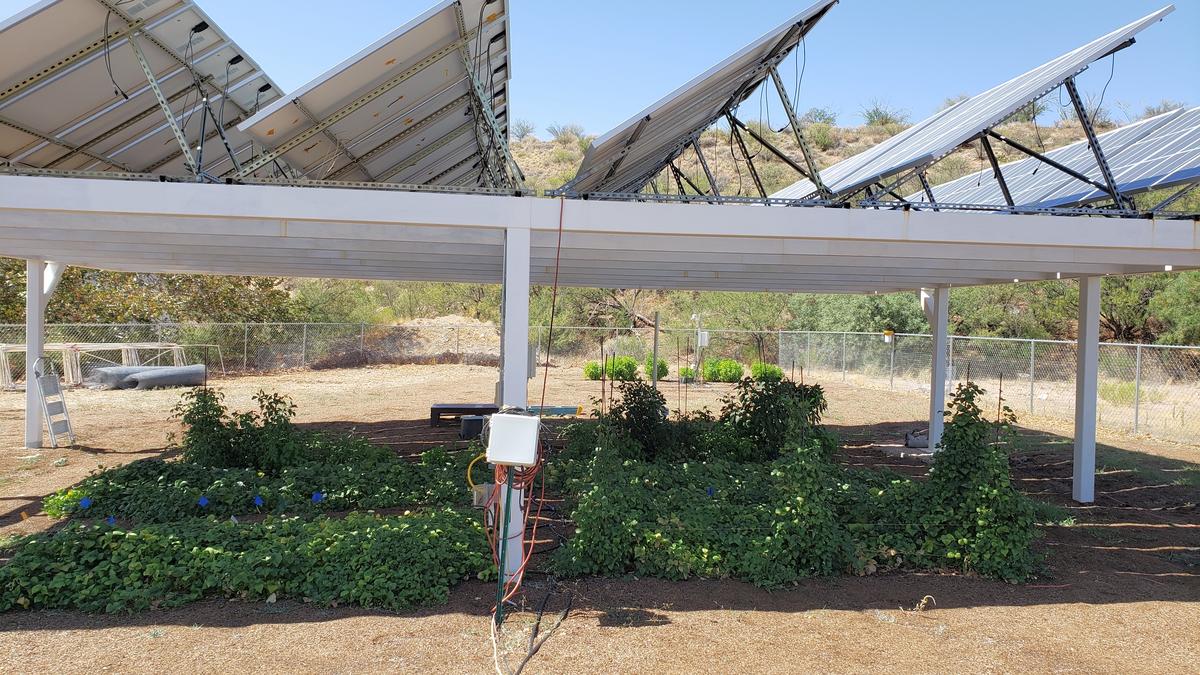In 1981, German scientists Adolf Goetzberger and Armin Zastrow published a foundational paper arguing that dual land use for food and energy could bring significant benefits. They proposed elevating solar modules by about 2 m above the ground to allow crops to grow underneath, giving rise to the concept of agriphotovoltaics (APVs).
APVs integrate solar energy generation with agricultural production, offering a model that maximises land-use efficiency while augmenting farmers’ income. With APVs, farmers will also be able to move energy back to the grid at a predetermined feed-in tariff, forging new streams of income alongside agricultural ones.
To accommodate APVs, the on-site solar infrastructure will have to be designed such that cultivation is possible between rows of solar panels, a.k.a. interspace orientation, and in the area available beneath the elevated panels, or overhead-stilted orientation.
There is a growing interest in APVs in India but in practice it is mostly limited to demonstrative pilots by research institutes or private developer-owned and -managed APV systems.
A recent report by the Indian Council for Research on International Economic Relations (coauthored by the authors of this article) examined an APV system in Najafgarh, Delhi. A farmer had leased his land to solar-energy company Sunmaster for 25 years to establish an APV facility.
Before the APV plant was operational, the farmer’s net income was typically Rs 41,000 per acre a year from traditional crops like wheat and mustard. After the APV was installed, the income included an annual rent of Rs 1 lakh per acre. The returns from the crop cultivation and energy sales went to the developer. The farmer said this rent-based income was a stable alternative that kept him from worrying about uncertainties in agricultural yield.
The report also explored a hypothetical scenario in which a farmer, in addition to receiving lease income, had negotiated to receive the agricultural revenue as well. If the farmer cultivated high-value as well as shade-loving crops like potato, tomato, and turmeric, the income could have been up to Rs 1.5 lakh per acre a year from crop cultivation in addition to Rs 1 lakh per acre in rent — a sixfold increase in income over traditional open farming alone and testament to APVs’ potential to boost farmers’ earnings.
Also, in addition to the apparent gains in land-use efficiency, APVs may also create favourable microclimatic conditions that reduce water loss from and heat stress on plants.
Need for standards
Unlike many other countries, India lacks standardised norms for APVs, creating ambiguity in project design. Countries leading in APV adoption, including Japan and Germany, could offer valuable lessons in this regard.
Japan requires all APV structures to be temporary and removable, a minimum panel height of 2 m, and a maximum crop yield loss of 20%. The Japanese government reviews projects for renewal every three years based on their effects on the agricultural output.
Likewise, Germany has introduced a standardised framework called DIN SPEC 91434, which requires all APV systems to maintain 66% of the original agricultural yield (called the reference yield) and limits the amount of arable land lost to solar infrastructure to up to 15%. The standard ensures agriculture remains the top of priority of APV development — even if the energy returns are high.
India can draw on these examples to define its national APV guidelines, including specifications on panel height, permissible yield loss, and land-use criteria. Such guidelines will be key to keep energy management from overshadowing agricultural interest, especially at scale.
Smallholder inclusion
Most Indian farmers are smallholders, owning less than 2 ha of land each, and have limited purchasing power. Scaling APV for smallholders will require leveraging farmer institutions such as FPOs and cooperatives. Sahyadri, one of a few FPOs in India to install a 250-kW APV system, is cultivating high-value crops like grapes and citrus lemon under solar panels. It shows how institutions can help farmers pool resources and provide stronger market linkages. Expanding institutional support — through grants or NABARD’s credit guarantee for APV investments — can also lower financial barriers to smallholders.
Indeed, the primary bottleneck for APV adoption in India is the high capital expenditure required for APV systems. While a typical 1-MW ground-mounted solar plant in 5 acres of land would cost around Rs 2.7 crore, an APV system will incur an additional 11% due to the specialised infrastructure it requires. So without a remunerative feed-in tariff (FiT), the economic viability of APVs remains uncertain.
For instance, under the current FiT of Rs 3.04/unit in Rajasthan’s PM-KUSUM scheme, the payback period for a 1-MW ground-mounted solar plant will be 15 years. But a higher FiT based on the thermal average power purchasing cost for the State Discoms of Rs 4.52/unit, the payback period will drop to four years. Such attractive FiTs could incentivise farmers and investors to invest in APVs.
The government can also float capacity-building programmes that train and equip farmers with the expertise to manage APV systems.
Two pillars
India currently doesn’t have any designated policy on agrivoltaics. There is an opportunity, however: a revamp of the Government of India’s flagship PM KUSUM scheme on agricultural solarisation to accommodate APVs in its delivery system could help scale the innovation across the country.
Solar power plants as commissioned within the grid-connected components of the scheme could also consider implementing models with infrastructure that allows crops to be cultivated simultaneously. This will allow India to take advantage of existing policy platforms to test and accelerate the innovation.
Success in the long run, however, still depends on two pillars: strong economic incentives for investors and a robust, farmer-centric policy framework.
Subhodeep Basu is research fellow and Laxmi Sharma is research associate, both at the Indian Council for Research on International Economic Relations (ICRIER).
Published – May 03, 2025 04:00 pm IST
